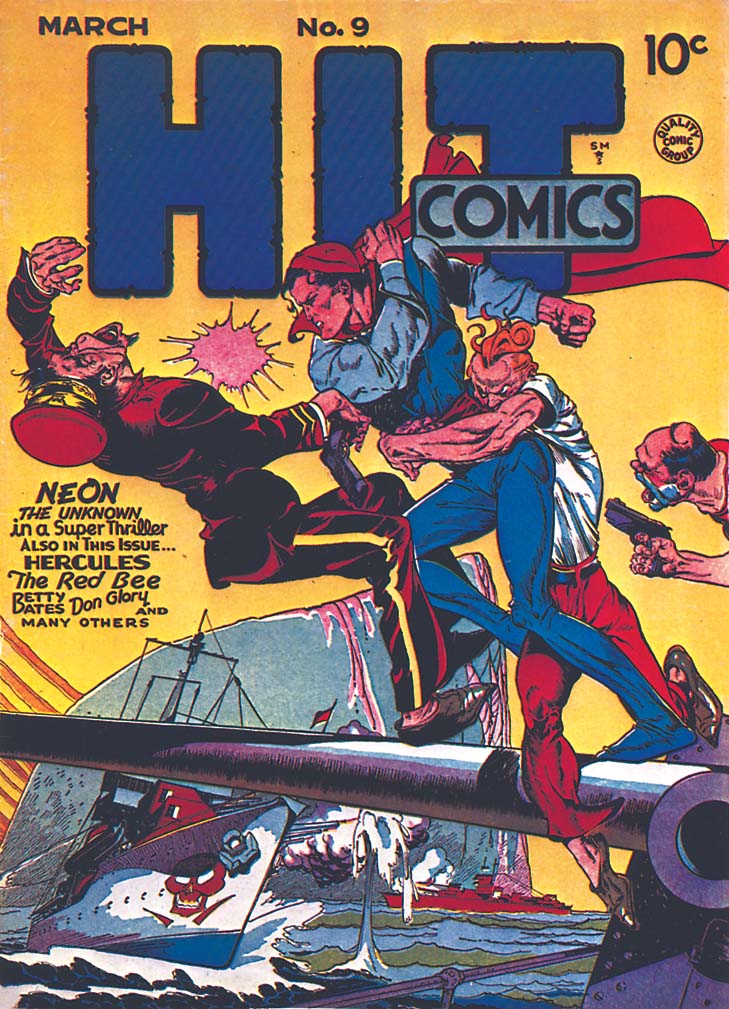|
|
|
|
|
 |
|
Hit Comics 9, March 1941, cover ©Quality Comics Group Editor: S. M. Iger This is one of the earliest entries in the Periodic Table of Comic Books. The cover of Hit Comics 9, drawn by venerable Golden Age artist Lou Fine, shows Neon the Unknown punching the lights out of an unfortunate fellow, who is apparently an officer in the Pointy-Shoed Pirates Corps. The glacier, cannons and waterspouts add a remarkable level of detail to this cover. Fine was no slave to convention, as Neon appears on the covers of Hit Comics 2, 4, 8 and 9 wearing two different costumes. Other Fine characters such as the Red Bee and Hercules also showed up in different versions of their costumes. Who says superheroes never change their clothes? Neon the Unknown first appeared in Hit Comics 1, June 1940. The superhero comic book industry was only about two years old, and new companies were quickly jumping on the bandwagon. Quality Comics Group also introduced Blackhawk and Plastic Man in 1941 and first moved Will Eisner's The Spirit to a comic book in 1942. The Eisner-Iger Studio was a major producer of comic-book work for several publishers; Neon the Unknown has the distinction of being one of the few heroes created by Jerry Iger himself. [1] Neon's origin falls into the "ingesting mysterious substance" category. Under orders from the sadistic Lieutenant Cracket, a company of Foreign Legionnaires in Africa is ordered to cross a desert to check on the restless Mbangi tribe. One by one, the legionnaires perish of thirst and exhaustion until only Tom Corbet (no relation to the 1950's TV hero Tom Corbett, Space Cadet) remains. Stumbling upon a pond covered with phosphorescent vapors, he cups his hands and drinks the liquid. "I feel like a new man!" he marvels and, moments later, looks like one too: his legionnaire uniform has been replaced by a superhero costume. He is attacked by a tiger and kills it with bolts of "neonic power" which shoot from his hands. Flying through the air on a spiral of light, he stumbles upon hangars where Morgan Crookes, a white man, has been using his great wealth to organize "all the primitive races of . . . the dark continent" into a force with which to conquer the world. After destroying Crookes' warplanes with his destructive abilities, he continues to fight tyranny and crime as Neon. [2] Neon's last Golden Age appearance was in Hit Comics 17, November 1941. DC Comics later acquired Neon along with the other Quality superheroes. In an issue of DC's All-Star Squadron, Neon died while fighting the Japanese, killed with The Invisible Hood, Miss America, The Red Torpedo and Magno when a kamikaze pilot crashed his Zero into their submarine. Neon's only connection to the element Neon is his name. Presumably, the name Neon was inspired by the bright lights of Times Square. [1] Neon is an appropriate sobriquet for a hero with light-based powers. Thanks to Richard Boucher of The Good Guys and Gals of the Golden Age Art Gallery for assistance. [1] Mike Benton, The Illustrated History of Superhero Comics of the Golden Age, Taylor Publishing Company, Dallas, TX, 1992, p. 167. [2] Jeff Rovin, The Encyclopedia of Superheroes, Facts On File Publications, New York, 1985, pp. 206-207. |
 |
